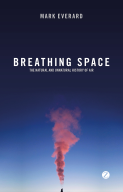Breathing Space: The Natural and Unnatural History of Air

Breathing Space treats air as an ecosystem – one that humans depend on, yet are prone to abusing. While the importance of air is obvious, it is often neglected in debate and policy around environmental management. Breathing Space seeks to counteract this neglect.
The book discusses air from a variety of angles. One section is scientific, with words like “flocculation” and “albedo” being discussed. Another part explores cultural understandings and representations of air, from paintings that attempt to capture the wind to the many air-based metaphors (such as “airing of grievances”) that suffuse different languages.
Also described are the many ways humans are damaging air quality (which in turn harms humans, of course). Air pollution is a worrisome feature of urban areas; in China, what expatriates call the “airpocalypse” is estimated to cause at least 350,000 premature deaths each year. And fossil fuel consumption, deforestation and some agricultural practices are driving climatic change. Everard also discusses non-chemical fouling of air, with noise pollution and light pollution altering the behaviour of plants, animals and humans alike.
All this establishes the vital importance of air to humans’ everyday lives, setting the stage for the more policy-specific discussion that follows. Everard calls for regulating air like any other natural resource. There are clear challenges to doing so: air is invisible, for one thing. The author emphasizes that the very ubiquity of air makes us likely to overlook it. In addition, air cannot be assigned to particular countries. Yet boundary complications, while important to recognize, have not forestalled useful debate on valuation of water bodies or carbon emissions.
This book shows that concern about air quality is nothing new; laws banning air pollution date back to Roman times. However, while the author traces the legal developments around air that have occurred since then, he contends that these have been fragmentary and insufficient, and that economic valuation needs to be incorporated.
Thus, applying an ecosystem services framework to air, one estimate is that the atmosphere has an economic value of at least 100 times the gross world product. At the UK level, this translates to a £65 “cost” per person each year. As well as examining how the value of air might be assessed, the author champions the ecosystem approach, which would treat air holistically. He provides specific recommendations in a number of connected areas ranging from transport to energy. Urban design, for instance, can promote smarter insulation and urban trees.
The book’s ultimate recommendation is for an international resolution that would protect air. This would be based on three “atmospheric principles”: 1) air is vulnerable, 2) air should be safeguarded through a participatory approach, and 3) the economic value of air should be recognized. Regardless of whether this call to action is taken up, readers will certainly appreciate air more after some time with this book.
Further reading:
Boon, Ronald G J, Anastasia Alexaki and Ernesto Herrera Becerra (2001), “The Ilo Clean Air Project: a local response to industrial pollution control in Peru”, Environment and Urbanization Vol 13, No 2, pages 215–232, available at http://eau.sagepub.com/content/13/2/215.abstract.
Book note prepared by Christine Ro
Search the Book notes database
Our Book notes database contains details and summaries of all the publications included in Book notes since 1993 - with details on how to obtain/download.
Use the search form above, or visit the Book notes landing page for more options and latest content.
For a searchable database for papers in Environment and Urbanization, go to http://eau.sagepub.com/

